Probabilistic Optimal Power Dispatch in Multi-Carrier Networked Microgrids under Uncertainties
Abstract
:1. Introduction
- A network of MCMGs structure is taken into account for studying MCMG optimal scheduling to resolve prevalent disadvantage of conventional structures of MGs. The centralized energy scheduling of the MCNMG is managed by the MMGCC which aggregates signals from each MGCC to economically distribute the energies to the consumers.
- Proposing a novel time-based demand side management model which correlates the final energy price of responsive loads for multiple carriers with energy market price, energy purchase, and on-site generations.
- The proposed network is studied under uncertainties of electrical and thermal loads, electricity price, and RERs generations.
2. The Multi-Carrier Networked Microgrid (MCNMG) Structure
3. System Model
3.1. Probabilistic Modeling
3.1.1. Modeling of Loads
3.1.2. Modeling of Electricity Market
3.1.3. Modeling of Renewable Generation
3.2. Energy Storage Modeling
3.3. Demand Side Management (DSM) Model
4. Problem Description
4.1. Objective Function
4.2. Problem Constraints
4.2.1. Energy Balance Constraints
4.2.2. Inequality Constraints
5. Simulation Results and Discussion
6. Conclusions
Author Contributions
Conflicts of Interest
Nomenclature
| Indices/Sets | |
| Indices for carriers (electrical, heat). | |
| Indices for carriers (electrical, gas). | |
| Index for electricity carrier. | |
| Index for natural gas carrier. | |
| Index for heat carrier. | |
| Index for CHP. | |
| Index for boiler. | |
| Index for transformer | |
| Index for photovoltaic. | |
| Index for wind turbine. | |
| Index for renewable units. | |
| Index for total. | |
| Index for period. | |
| Index for initial value. | |
| Index for carriers type. | |
| Index for microgrid No. | |
| Index for samples. | |
| Index for charge rate in storage interface. | |
| Index for discharge rate in storage interface. | |
| Index for standby energy losses in energy storage. | |
| Index for operation and maintenance. | |
| Index for wind turbine cut-in speed. | |
| Index for wind turbine cut-out speed. | |
| Index for rated speed or power. | |
| Index for a certain radiation point. | |
| Binary variable for energy charging or discharging mode in energy storage. | |
| Final energy price of responsive load ($/KWh). | |
| Index for standard conditions. | |
| Parameters and Constants | |
| non-responsive load (KWh). | |
| responsive load (KWh). | |
| Energy purchase price ($/KWh). | |
| Energy sales price ($/KWh). | |
| Energy efficiency of units. | |
| Maintenance coefficient. | |
| Elasticity matrix. | |
| Elasticity matrix element. | |
| Standard deviation of the uncertain variable. | |
| Mean value of the uncertain variable. | |
| Wind speed (m/s). | |
| Solar radiation (W/m2). | |
| , | Shape and scale parameters of Weibull distribution function (w/m2). |
| Beta distribution shape factors (KW/m2). | |
| Variables | |
| Transferred energy (KWh). | |
| Purchased energy (KWh). | |
| Energy generation by each units (KWh). | |
| Rated power (KW). | |
| Renewable power generation (KWh). | |
| Storage charge and discharge ramp rate (KWh). | |
| State of charge in energy storages (KWh). | |
| Storage energy derivative (KWh). | |
| Storage coupling factor. | |
| Dispatch factor (%). | |
| Cost ($). | |
References
- Joseph, A.; Shahidehpour, M. Battery storage systems in electric power systems. In Proceedings of the 2006 IEEE Power Engineering Society General Meeting, Montreal, QC, Canada, 18–22 June 2006; IEEE: Piscataway, NJ, USA, 2006; p. 8. [Google Scholar]
- Parhizi, S.; Lotfi, H.; Khodaei, A.; Bahramirad, S. State of the art in research on microgrids: A review. IEEE Access 2015, 3, 890–925. [Google Scholar] [CrossRef]
- Energy & Environmental Resources Group. U.S. Department of Energy DOE Microgrid Workshop Report; The Office of Electricity Delivery and Energy Reliability Smart Grid R&D Program: San Diego, CA, USA, 2011; pp. 1–32. [Google Scholar]
- Su, W.; Wang, J.; Zhang, K.; Huang, A.Q. Model predictive control-based power dispatch for distribution system considering plug-in electric vehicle uncertainty. Electr. Power Syst. Res. 2014, 106, 29–35. [Google Scholar] [CrossRef]
- Hussain, A.; Lee, J.-H.; Kim, J.-Y.; Kim, H.-M.; Song, N.-O. An Algorithm for Optimal Multi-Microgrid Operation Including Heat Network. In Proceedings of the 2015 IPEG, Daejon, Korea, 17 October 2015. [Google Scholar]
- Nikmehr, N.; Najafi-Ravadanegh, S. Probabilistic optimal power dispatch in multi-microgrids using heuristic algorithms. In Proceedings of the 2014 Smart Grid Conference (SGC), Tehran, Iran, 9–10 December 2014; IEEE: Piscataway, NJ, USA, 2014; pp. 1–6. [Google Scholar]
- Katiraei, F.; Iravani, R.; Hatziargyriou, N.; Dimeas, A. Microgrids management. IEEE Power Energy Mag. 2008, 6, 54–65. [Google Scholar] [CrossRef]
- Laaksonen, H.J. Protection principles for future microgrids. IEEE Trans. Power Electron. 2010, 25, 2910–2918. [Google Scholar] [CrossRef]
- Nikmehr, N.; Ravadanegh, S.N. Analysis of Reliability Indices in Next Generation Microgrids under Uncertainties of Load and Renewable Power Production. AUT J. Electr. Eng. 2016, 48, 41–51. [Google Scholar] [CrossRef]
- Guo, L.; Liu, W.; Cai, J.; Hong, B.; Wang, C. A two-stage optimal planning and design method for combined cooling, heat and power microgrid system. Energy Convers. Manag. 2013, 74, 433–445. [Google Scholar] [CrossRef]
- Arefifar, S.A.; Mohamed, Y.A.R.I.; El-Fouly, T.H.M. Optimum microgrid design for enhancing reliability and supply-security. IEEE Trans. Smart Grid 2013, 4, 1567–1575. [Google Scholar] [CrossRef]
- Nikmehr, N.; Ravadanegh, S.N. Optimal Power Dispatch of Multi-Microgrids at Future Smart Distribution Grids. IEEE Trans. Smart Grid 2015, 6, 1648–1657. [Google Scholar] [CrossRef]
- Teng, J.H.; Liu, Y.H.; Chen, C.Y.; Chen, C.F. Value-based distributed generator placements for service quality improvements. Int. J. Electr. Power Energy Syst. 2007, 29, 268–274. [Google Scholar] [CrossRef]
- Koutsopoulos, I.; Tassiulas, L. Challenges in demand load control for the smart grid. Netw. IEEE 2011, 25, 16–21. [Google Scholar] [CrossRef]
- Hussain, A.; Lee, J.-H.; Kim, H.-M. An Optimal Energy Management Strategy for Thermally Networked Microgrids in Grid-Connected Mode. Int. J. Smart Home 2016, 10, 239–258. [Google Scholar] [CrossRef]
- Song, N.-O.; Lee, J.-H.; Kim, H.-M. Optimal Electric and Heat Energy Management of Multi-Microgrids with Sequentially-Coordinated Operations. Energies 2016, 9, 473. [Google Scholar] [CrossRef]
- Mohamed, F.A.; Koivo, H.N. Online Management of MicroGrid with Battery Storage Using Multiobjective Optimization. In Proceedings of the 2007 International Conference on Power Engineering, Energy and Electrical Drives, Setubal, Portugal, 12–14 April 2007; pp. 231–236. [Google Scholar]
- Ravadanegh, S.N.; Farhudi, T.; Nikmehr, N.; Oskuee, M.R.J. Statistical analysis on results of optimal power sharing between linked microgrids. Int. J. Ambient Energy 2016. [Google Scholar] [CrossRef]
- Kinjyo, Y.; Asato, B.; Yona, A.; Senjyu, T.; Funabashi, T.; Kim, C.-H. Optimal Operation of Smart Grid with Fuel Cell in Isolated Islands. J. Int. Counc. Electr. Eng. 2012, 2, 423–429. [Google Scholar] [CrossRef]
- Esmat, A.; Magdy, A.; ElKhattam, W.; ElBakly, A.M. A novel Energy Management System using Ant Colony Optimization for micro-grids. In Proceedings of the 2013 3rd International Conference on Electric Power and Energy Conversion Systems, Istanbul, Turkey, 2–4 October 2013; pp. 1–6. [Google Scholar] [CrossRef]
- Urias, M.E.G.; Sanchez, E.N.; Ricalde, L.J. Electrical Microgrid Optimization via a New Recurrent Neural Network. IEEE Syst. J. 2015, 9, 945–953. [Google Scholar] [CrossRef]
- Mohamed, F.A.; Koivo, H.N. Multiobjective optimization using Mesh Adaptive Direct Search for power dispatch problem of microgrid. Int. J. Electr. Power Energy Syst. 2012, 42, 728–735. [Google Scholar] [CrossRef]
- Ferruzzi, G.; Graditi, G.; Rossi, F.; Russo, A. Optimal Operation of a Residential Microgrid: The Role of Demand Side Management. Intell. Ind. Syst. 2015, 1, 61–82. [Google Scholar] [CrossRef]
- Nikmehr, N.; Ravadanegh, S.N. Solving probabilistic load flow in smart distribution grids using heuristic methods. J. Renew. Sustain. Energy 2015, 7. [Google Scholar] [CrossRef]
- Huang, C.; Yue, D.; Deng, S.; Xie, J. Optimal scheduling of microgrid with multiple distributed resources using interval optimization. Energies 2017, 10. [Google Scholar] [CrossRef]
- Aien, M.; Fotuhi-Firuzabad, M.; Rashidinejad, M. Probabilistic optimal power flow in correlated hybrid wind-photovoltaic power systems. IEEE Trans. Smart Grid 2014, 5, 130–138. [Google Scholar] [CrossRef]
- Ravadanegh, S.N.; Nikmehr, N. Heuristic probabilistic power flow algorithm for microgrids operation and planning. IET Gener. Trans. Distrib. 2015, 9, 985–995. [Google Scholar] [CrossRef]
- Liang, H.; Zhuang, W. Stochastic modeling and optimization in a microgrid: A survey. Energies 2014, 7, 2027–2050. [Google Scholar] [CrossRef]
- Motevasel, M.; Seifi, A.R. Expert energy management of a micro-grid considering wind energy uncertainty. Energy Convers. Manag. 2014, 83, 58–72. [Google Scholar] [CrossRef]
- Napoli, R.; Sajjad, I.A.; Chicco, G. Probabilistic generation of time-coupled aggregate residential demand patterns. IET Gener. Trans. Distrib. 2015. [Google Scholar] [CrossRef]
- De Bosio, F.; Luna, A.C.; Ribeiro, L.A.D.S.; Graells, M.; Saavedra, O.R.; Guerrero, J.M. Analysis and improvement of the energy management of an isolated microgrid in Lencois island based on a linear optimization approach. In Proceedings of the ECCE 2016—IEEE Energy Conversion Congress and Exposition, Milwaukee, WI, USA, 18–22 September 2016. [Google Scholar]
- Aien, M.; Rashidinejad, M.; Fotuhi-Firuzabad, M. On Possibilistic and Probabilistic Uncertainty Assessment of Power Flow Problem: A Review and a New Approach. Renew. Sustain. Energy Rev. 2014, 37, 883–895. [Google Scholar] [CrossRef]
- Borkowska, B. Probabilistic Load Flow. IEEE Trans. Power Appar. Syst. 1974, PAS-93, 752–759. [Google Scholar] [CrossRef]
- Nikmehr, N.; Ravadanegh, S.N. A study on optimal power sharing in interconnected microgrids under uncertainty. Int. Trans. Electr. Energy Syst. 2016, 26, 208–232. [Google Scholar] [CrossRef]
- Stefopoulos, G.K.; Meliopoulos, A.P.; Cokkinides, G.J. Probabilistic power flow with non-conforming electric loads. Int.J. Electr. Power Energy Syst. 2005, 27, 627–634. [Google Scholar] [CrossRef]
- Baziar, A.; Kavousi-Fard, A. Considering uncertainty in the optimal energy management of renewable micro-grids including storage devices. Renew. Energy 2013, 59, 158–166. [Google Scholar] [CrossRef]
- Su, C.L. Probabilistic load-flow computation using point estimate method. IEEE Trans. Power Syst. 2005, 20, 1843–1851. [Google Scholar] [CrossRef]
- Zhang, P.; Lee, S.T. Probabilistic Load Flow Computation Using the Method of Combined Cumulants and Gram-Charlier Expansion. IEEE Trans. Power Syst. 2004, 19, 676–682. [Google Scholar] [CrossRef]
- Schellenberg, A.; Rosehart, W.; Aguado, J. Cumulant-based probabilistic optimal power flow (P-OPF) with Gaussian and Gamma distributions. IEEE Trans. Power Syst. 2005, 20, 773–781. [Google Scholar] [CrossRef]
- Soroudi, A.; Amraee, T. Decision making under uncertainty in energy systems: State of the art. Renew. Sustain. Energy Rev. 2013, 28, 376–384. [Google Scholar] [CrossRef]
- Hussain, A.; Bui, V.-H.; Kim, H.-M. Robust Optimization-Based Scheduling of Multi-Microgrids Considering Uncertainties. Energies 2016, 9, 278. [Google Scholar] [CrossRef]
- Aggarwal, S.K.; Saini, L.M.; Kumar, A. Electricity price forecasting in deregulated markets: A review and evaluation. Int. J. Electr. Power Energy Syst. 2009, 31, 13–22. [Google Scholar] [CrossRef]
- Kumbaroglu, G.; Madlener, R. Evaluation of economically optimal retrofit investment options for energy savings in buildings. Energy Build. 2012, 49, 327–334. [Google Scholar] [CrossRef]
- Sharma, K.; Bhakar, R.; Tiwari, H.P. Influence of price uncertainty modeling accuracy on bidding strategy of a multi-unit GenCo in electricity markets. Iran. J. Sci. Technol. Trans. Electr. Eng. 2014, 38, 191–203. [Google Scholar] [CrossRef]
- Prodan, I.; Zio, E. A model predictive control framework for reliable microgrid energy management. Int. J. Electr. Power Energy Syst. 2014, 61, 399–409. [Google Scholar] [CrossRef]
- Nikmehr, N.; Najafi-Ravadanegh, S. Optimal operation of distributed generations in micro-grids under uncertainties in load and renewable power generation using heuristic algorithm. IET Renew. Power Gener. 2015, 9, 982–990. [Google Scholar] [CrossRef]
- Bahramirad, S.; Reder, W.; Khodaei, A. Reliability-Constrained Optimal Sizing of Energy Storage System in a Microgrid. IEEE Trans. Smart Grid 2012, 3, 2056–2062. [Google Scholar] [CrossRef]
- Sheikhi, A.; Rayati, M.; Bahrami, S.; Ranjbar, A.M. Integrated demand side management game in smart energy hubs. IEEE Trans. Smart Grid 2015, 6, 675–683. [Google Scholar] [CrossRef]
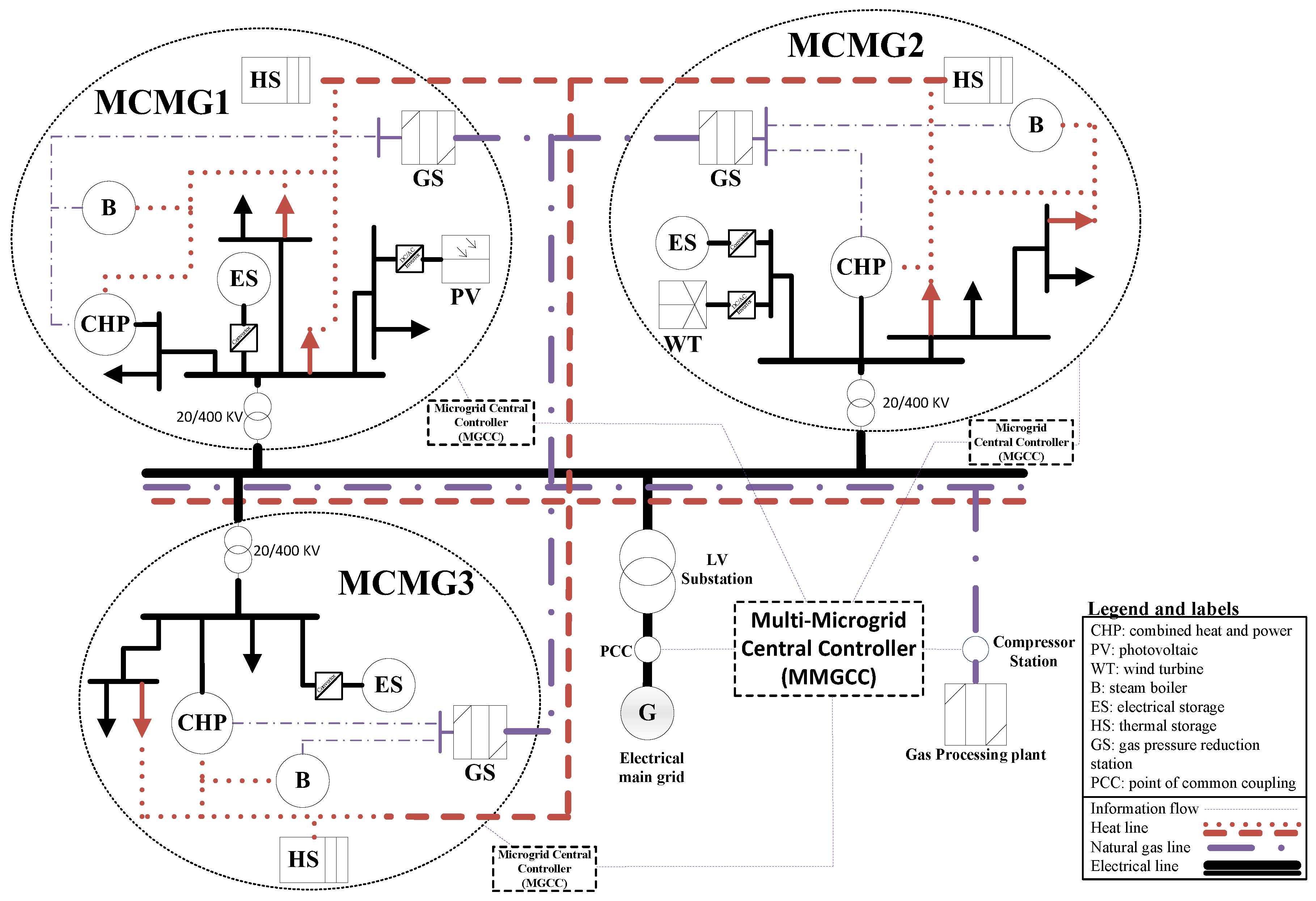
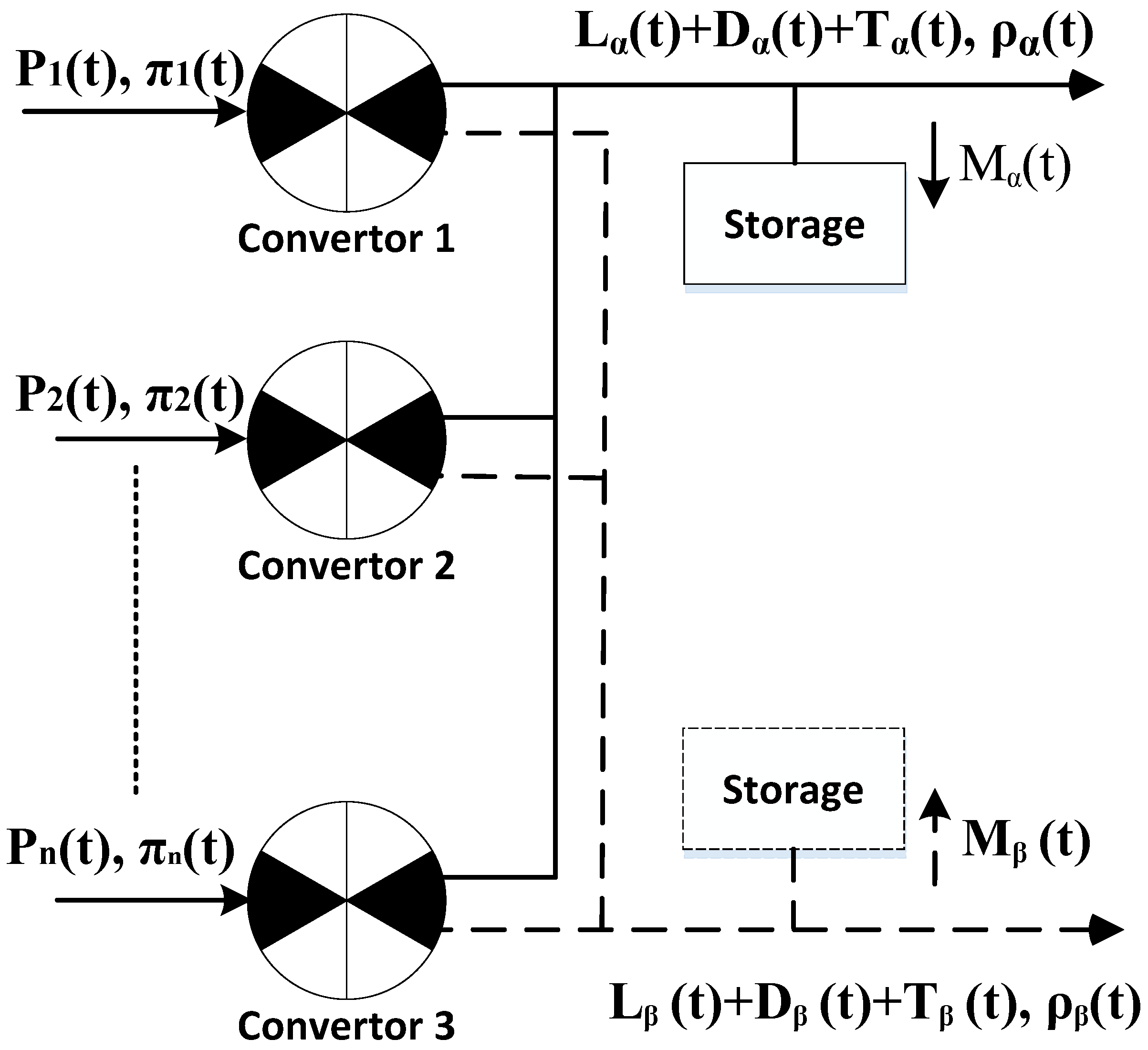

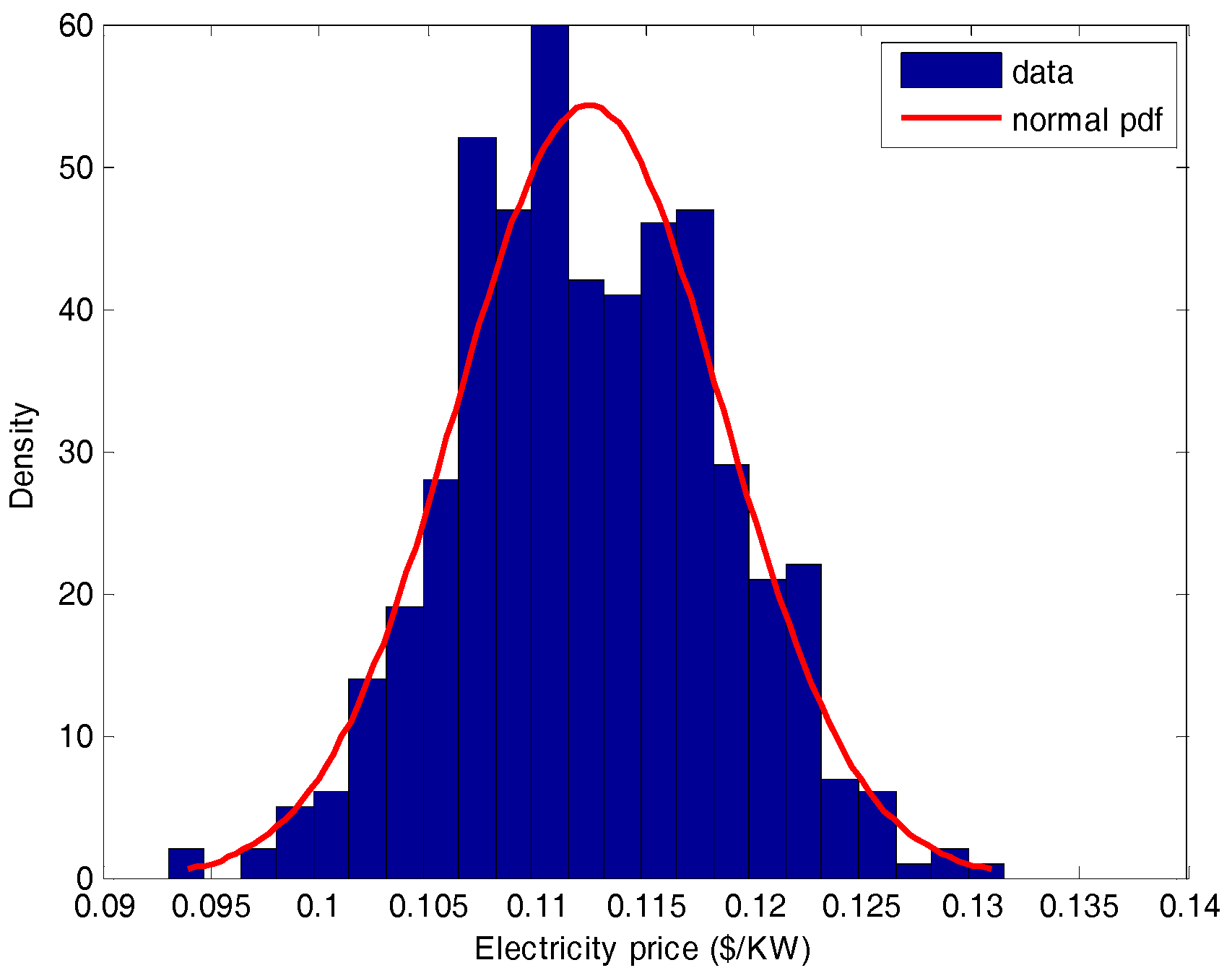

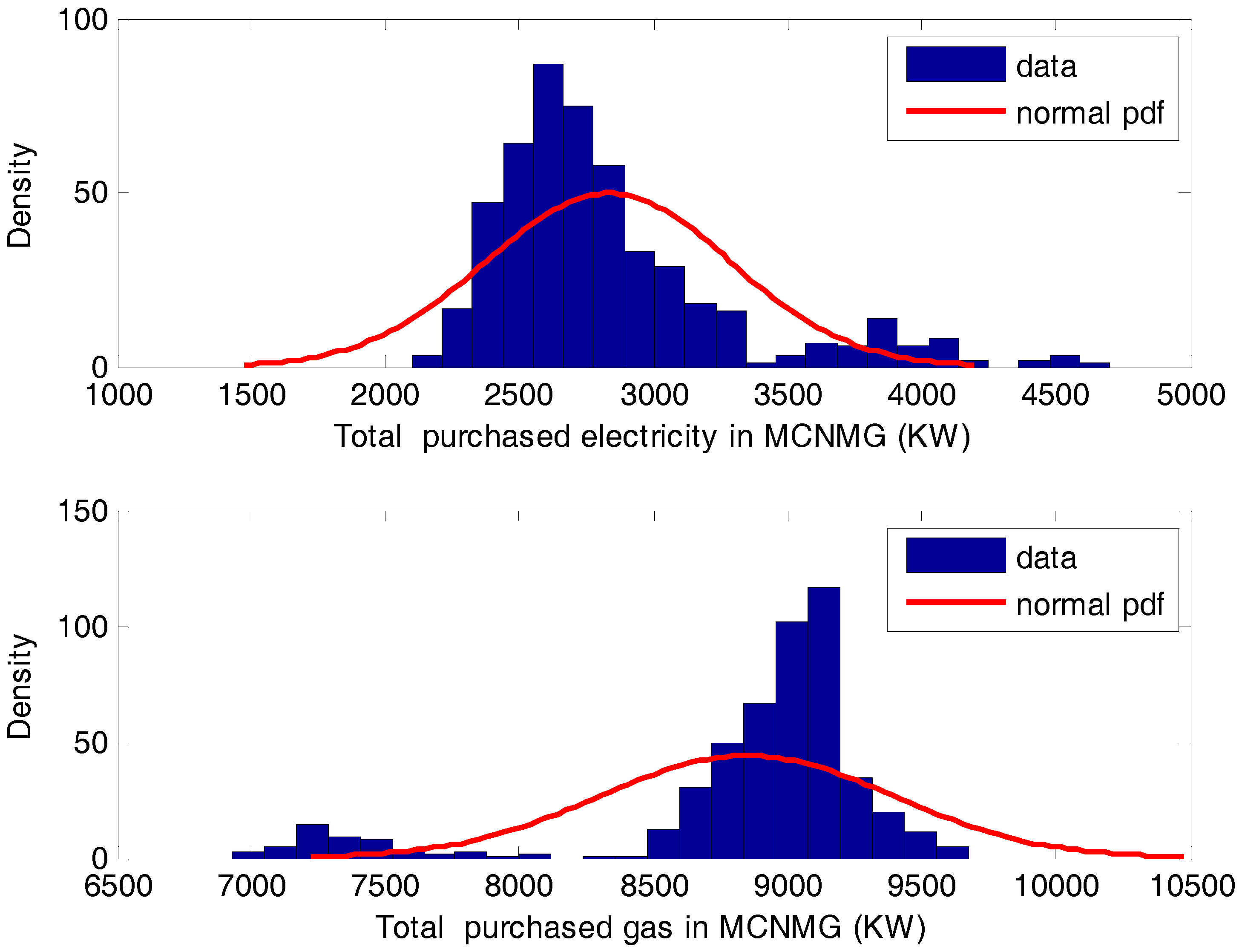


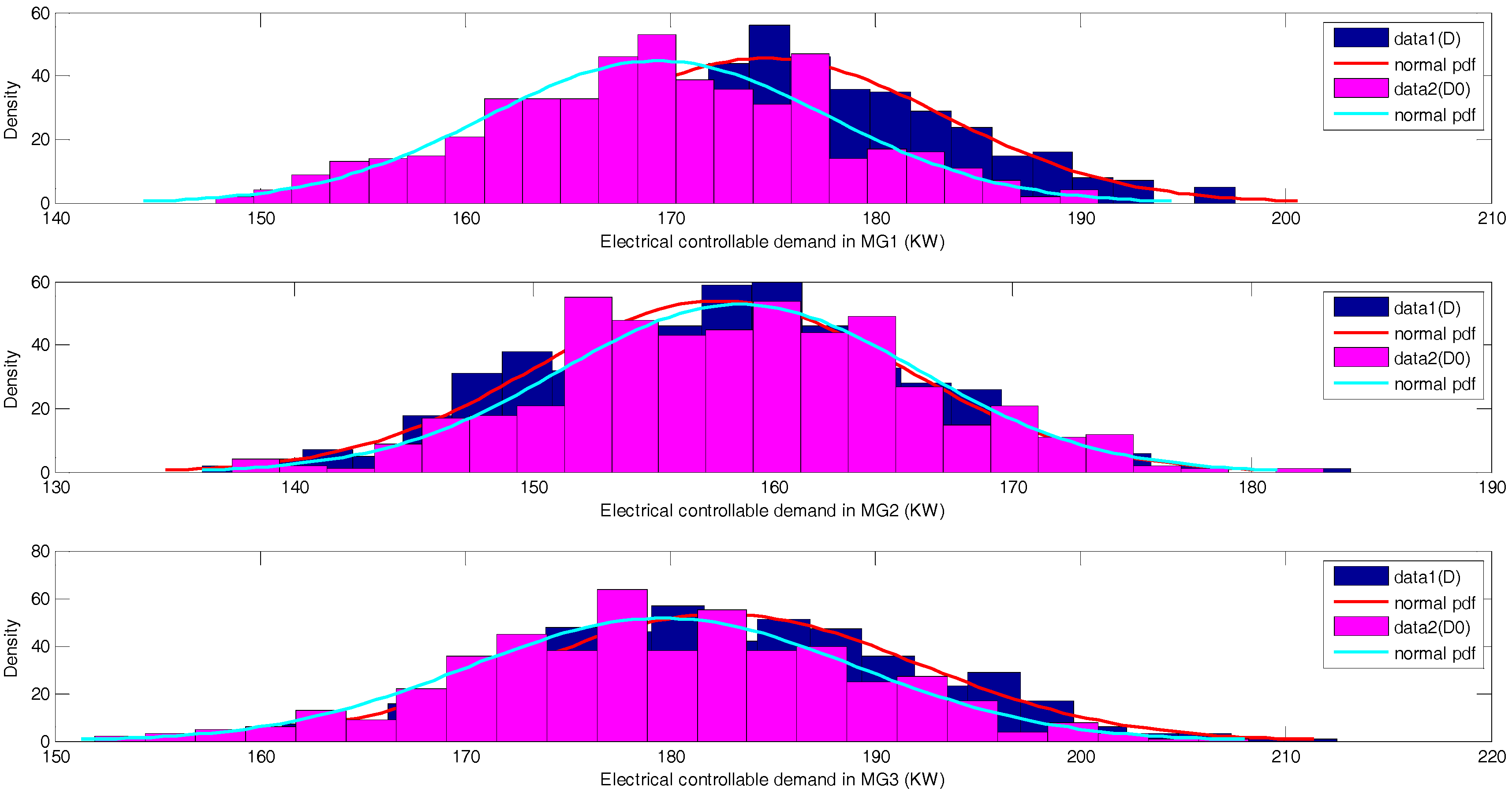
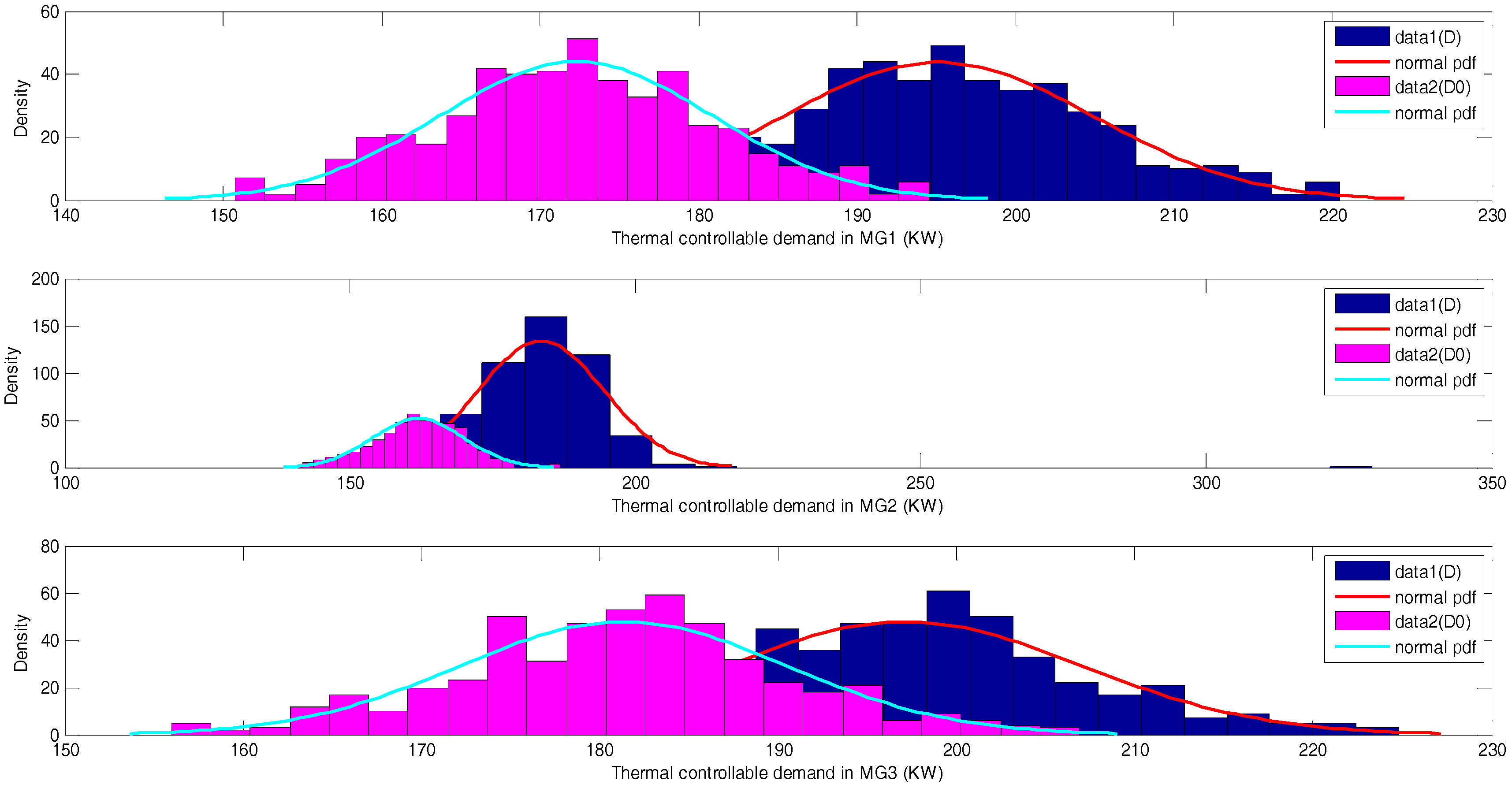
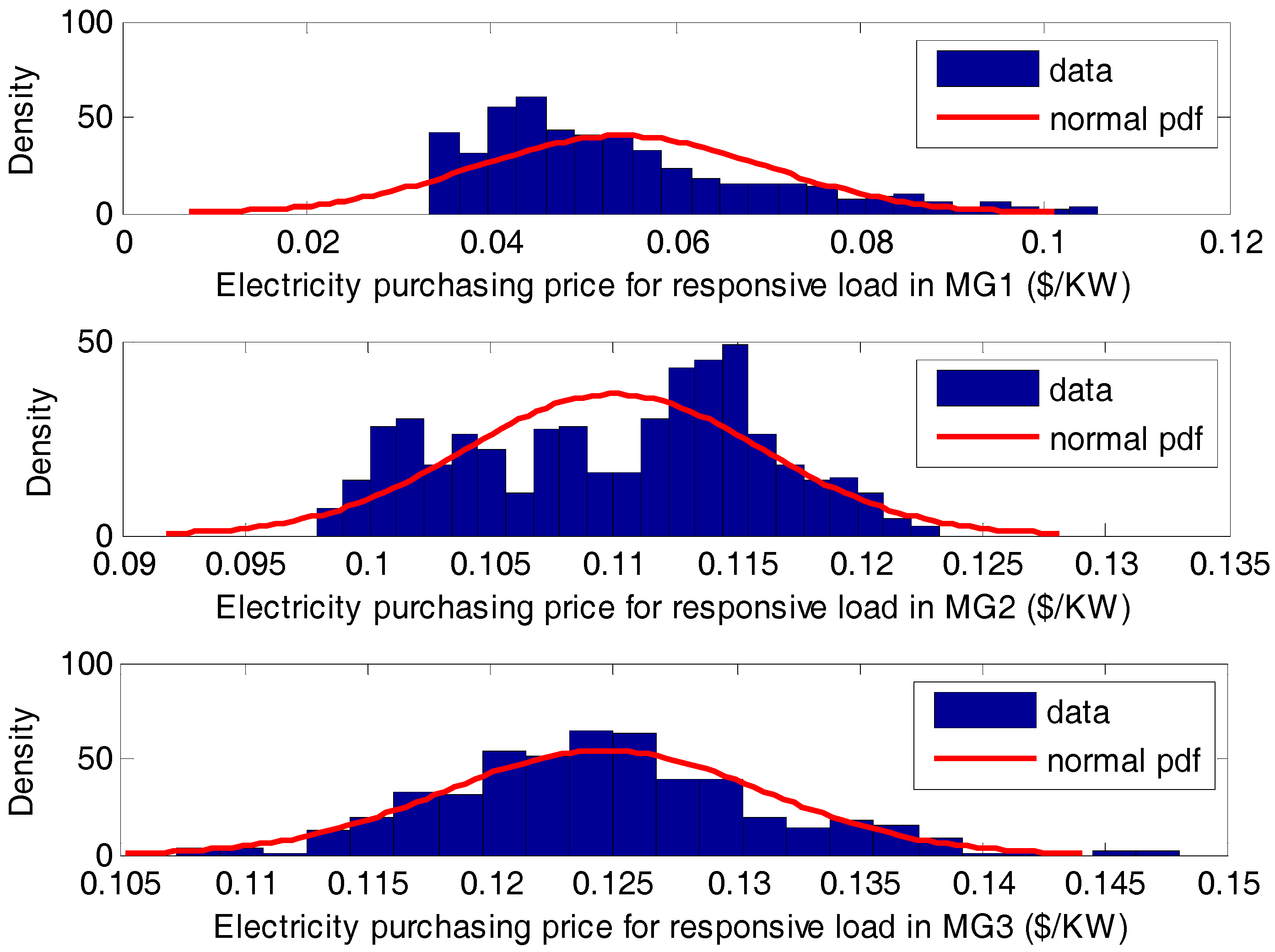

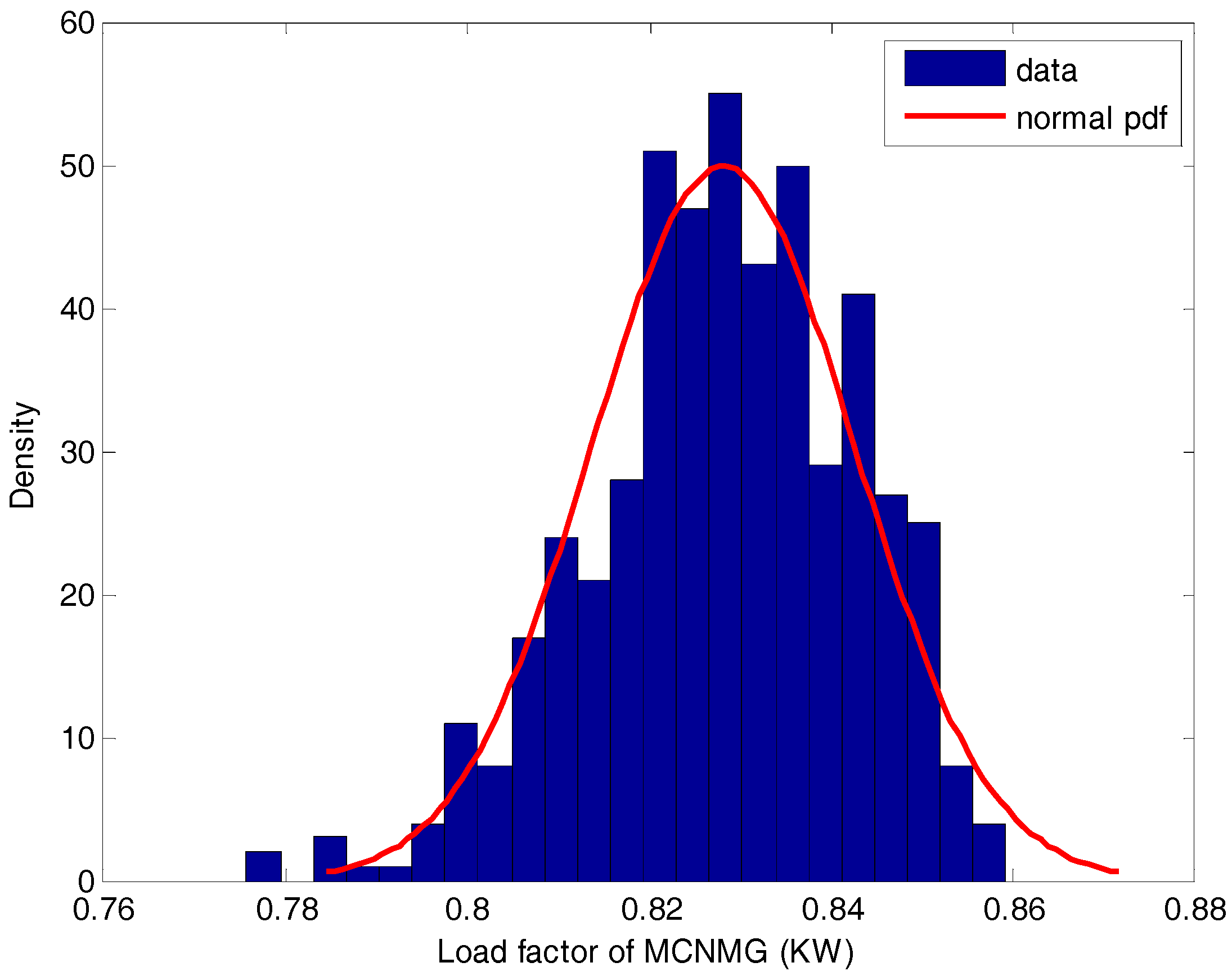

| Element | MCMG No. | Maximum Capacity (KW) | Efficiencies (%) | Maintenance Coefficient ($/KWh) | ||
|---|---|---|---|---|---|---|
| el. | th. | |||||
| Transformer | 1 | 5000 | 92 | - | 92 | 0.002 |
| 2 | 90 | - | 90 | |||
| 3 | 90 | - | 90 | |||
| CHP | 1 | 1100 | 40 | 40 | 80 | 0.00587 |
| 2 | 1000 | 40 | 30 | 70 | ||
| 3 | 900 | 30 | 30 | 60 | ||
| Boiler | 1 | 1700 | - | 85 | 85 | 0.001 |
| 2 | 1500 | - | 87 | 87 | ||
| 3 | 1900 | - | 90 | 90 | ||
| PV | 1 | 2000 | 95 | - | 95 | - |
| WT | 2 | 1000 | 90 | - | 90 | - |
| Electrical storage | 1 to 3 | 1/90 | - | - | - | - |
| Heat storage | 1 to 3 | 90 | - | - | - | - |
| Storage Interface (char, disch) | 1 to 3 | −90/90 | - | - | 95, 90 | - |
| WT | |||
| PV |
| MCMG No. | Unit Type | Mean Value of Power (KW) | STD of Power (KW) | Skewness of Power | Total Mean Value of O&M Cost ($) | Total STD of O & M Cost ($) | Skewness of O & M Cost | |
|---|---|---|---|---|---|---|---|---|
| MCMG1 | CHP | e | 1100 | 0 | - | 95.72 | 9.6073 | 0.2331 |
| h | 1100 | 4.19676 × 10−14 | 0.9570 | |||||
| Transformer | 73.2904 | 149.268 | 2.2309 | |||||
| PV | 844.965 | 430.972 | 0.2112 | |||||
| Boiler | 101.601 | 209.787 | 2.5186 | |||||
| Electrical storage | 45.4163 | 44.121 | 0.0056 | |||||
| Heat storage | 54.173 | 43.6273 | −0.4159 | |||||
| Sold electricity | 307.161 | 325.459 | 0.8876 | |||||
| MCMG2 | CHP | e | 898.908 | 297.075 | −2.6617 | 181.083 | 7.00013 | −0.4125 |
| h | 674.181 | 222.806 | −2.6617 | |||||
| Transformer | 693.105 | 326.029 | 2.1953 | |||||
| Boiler | 1410.3 | 126.403 | −1.3977 | |||||
| WT | 11.008 | 9.46023 | 0.5919 | |||||
| Electrical storage | 37.312 | 43.784 | 0.3744 | |||||
| Heat storage | 51.3446 | 44.252 | −0.2832 | |||||
| Sold electricity | 0 | 0 | 0 | |||||
| MCMG3 | CHP | e | 0 | 0 | - | 121.143 | 0.853093 | 0.0336 |
| h | 0 | 0 | - | |||||
| Transformer | 1784.01 | 113.948 | −0.1443 | |||||
| Boiler | 1900 | 0 | - | |||||
| Electrical storage | 44.432 | 44.5317 | 0.0480 | |||||
| Heat storage | 55.6215 | 43.3282 | −0.4857 | |||||
| Sold electricity | 0 | 0 | 0 | |||||
| Before Trade in MCNMG | After Trade in MCNMG | |||||
|---|---|---|---|---|---|---|
| Mean | STD | Skewness | Mean | STD | Skewness | |
| Heat wastage (KW) | 67.5982 | 1.13846 | 11.2843 | 6.46196 | 1.54054 | 12.4334 |
| Total cost ($) | 22,016.3 | 606.951 | −0.3652 | 21,734.6 | 608.727 | −0.1462 |
| Responsive Load Participation | 10% of Total Load | 30% of Total Load | ||||
|---|---|---|---|---|---|---|
| Mean | STD | Skewness | Mean | STD | Skewness | |
| LF | 0.828094 | 0.0145232 | −0.4689 | 0.835028 | 0.0148382 | −0.4308 |
| Total cost ($) | 21876.3 | 606.951 | −0.3652 | 21584.3 | 622.571 | −0.3357 |
© 2017 by the authors. Licensee MDPI, Basel, Switzerland. This article is an open access article distributed under the terms and conditions of the Creative Commons Attribution (CC BY) license (http://creativecommons.org/licenses/by/4.0/).
Share and Cite
Amir, V.; Jadid, S.; Ehsan, M. Probabilistic Optimal Power Dispatch in Multi-Carrier Networked Microgrids under Uncertainties. Energies 2017, 10, 1770. https://doi.org/10.3390/en10111770
Amir V, Jadid S, Ehsan M. Probabilistic Optimal Power Dispatch in Multi-Carrier Networked Microgrids under Uncertainties. Energies. 2017; 10(11):1770. https://doi.org/10.3390/en10111770
Chicago/Turabian StyleAmir, Vahid, Shahram Jadid, and Mehdi Ehsan. 2017. "Probabilistic Optimal Power Dispatch in Multi-Carrier Networked Microgrids under Uncertainties" Energies 10, no. 11: 1770. https://doi.org/10.3390/en10111770
APA StyleAmir, V., Jadid, S., & Ehsan, M. (2017). Probabilistic Optimal Power Dispatch in Multi-Carrier Networked Microgrids under Uncertainties. Energies, 10(11), 1770. https://doi.org/10.3390/en10111770





